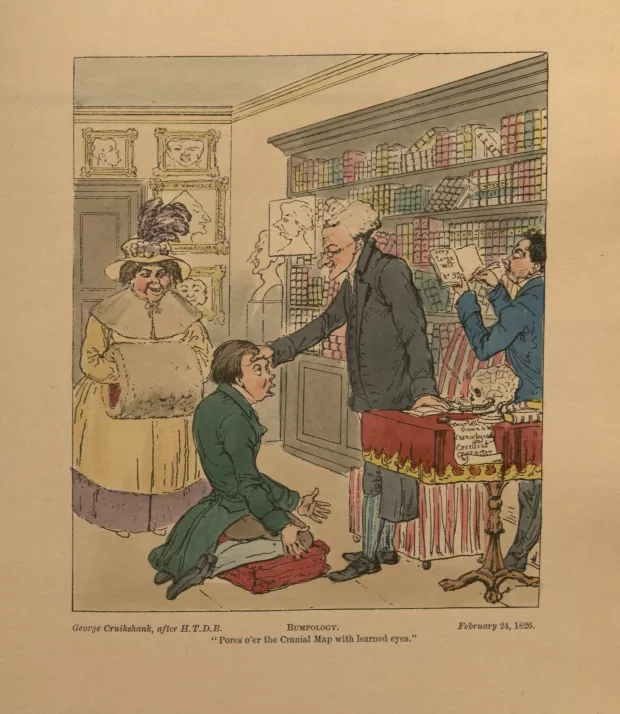Creation Date
4 February 182613
Height
13 cm
Width
11 cm
Medium
Genre
Description
A phrenologist, identified as J. De Ville, places his right hand on the forehead of a young man who is kneeling at the center of the image. A well-dressed woman, probably the young man’s mother, observes the action from the left of the scene while a clerk writes "very large wit no 32" in a book at the far right. A table stands in front of De Ville and holds books, a phrenologically numbered skull, and a note recording the murderer J. Thurtell as a "craniologically...excellent character." The scene is set in an office: a bookshelf lines the right wall, and portraits of phrenologically interesting specimens hang at the back of the room.
Cruikshank’s Bumpology (1826) satirizes a particular phrenological moment—James De Ville’s examination of children in order to predict their intellectual, artistic, and moral potential—that was well documented in contemporary periodical accounts. The print also includes a reference to a murderer, John Thurtell, suggesting the public’s interest in using phrenology to identify criminals.
By illustrating the "'primitive" or "natural inclination of man" as explained by phrenologists, Cruikshank's work reveals the association between disfigurement and character as it was used by both phrenologists and caricaturists (Stafford, "Conjecturing the Unseen" 344). More specifically, this piece pokes fun at the pseudo-science's claim to an infallible "reading" of the subject, while also revealing and satirizing its immense popularity. Bumpology also implicitly questions the appropriate uses of phrenology, a topic of popular debate since the latter's inception as a "scientific" field. While the viewer’s attention is focused on the domestic application of phrenology to the young man’s educational advancement, the reference to Thurtell suggests phrenology’s other uses. Cruikshank thus records the public’s interest in using phrenology to identify criminals, an interest also documented in news articles and phrenological tracts like The Phrenological Journal (“Further Particulars of Thurtell, &c.”; Phrenological Journal 297ff). The application of phrenology to a photographic archive of criminals is well documented by Allen Sekula (11ff).
Social caricature satirized popular trends not simply in order to entertain but also to inform or alter public opinion. Caricatures of phrenology taught the “clinical gaze” by illustrating the pseudo-science’s usefulness (or lack thereof); in this case, phrenology is shown as a potential tool in the development of individualized educational programs for children based entirely on a reading of an exterior believed to correspond to one's intellectual properties.
Associated Persons
Associated Works
Copyright
Copyright 2009, Department of Special Collections, Memorial Library, University of Wisconsin-Madison, Madison, WI
Collection
Accession Number
CA1765
Additional Information
Bibliography
Cowling, Mary. The Artist as Anthropologist: The Representation of Type and Character in Victorian Art. Cambridge: Cambridge UP, 1989. Print.
Cruikshank, George. Phrenological Illustrations. London: George Cruikshank, 1826. Print.
Cruikshank, Isaac. The Cruikshankian Momus. London: John C. Nimmo, 1892. Print.
Fraser, Angus. “Thurtell, John (1794–1824).” Oxford Dictionary of National Biography. Ed. H. C. G. Matthew and Brian Harrison. Oxford: OUP, 2004. Web. 30 Apr. 2009.
“Further Particulars of Thurtell, &c.” Examiner 18 Jan. 1824: 40-41. Print.
H., A. “Letter.” The Gentleman’s Magazine Sept. 1825: 216-7. Print.
H., R. “Phrenology.” Republican 14.3 (1826): 82-6. Print.
Karp, Diane. "Madness, Mania, Melancholy: The Artist as Observer." Philadelphia Museum of Art Bulletin 80.342 (1984): 1-24. Print.
McLaren, Angus. "Phrenology: Medium and Message." The Journal of Modern History 46.1 (1974): 86-97. Print.
Patten, Robert. "Conventions of Georgian Caricature." Art Journal 43.4 (1983): 331-8. Print.
--. George Cruikshank's Life, Times, and Art: 1792-1835. Vol. 1. Rutgers UP, 1992. Print.
The Phrenological Journal and Miscellany Vol. 3. (August, 1825 – October, 1826): Edinburgh, 1826. Print.
"Phrenology." The Literary Gazette: A Weekly Journal of Literature, Science, and the Fine Arts.660 (1829): 599-600.
Sekula, Allen. “The Body and the Archive.” October 39 (1986): 3-64. Print.
Stafford, Barbara Maria. Body Criticism: Imagining the Unseen in Enlightenment Art and Medicine. Cambridge, MA: MIT Press: 1991. Print.
Stafford, Barbara Maria. "From 'Brilliant Ideas' to 'Fitful Thoughts': Conjecturing the Unseen in Late Eighteenth-Century Art." Zeitschrift fur Kunstgeschichte 48.3 (1985): 329-63. Print.

